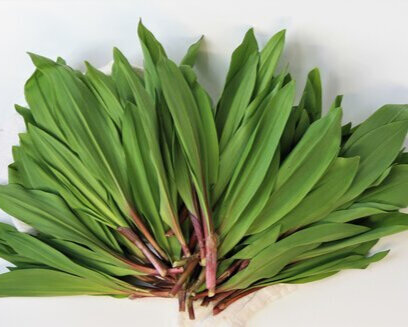B&E’s Trees Sustainable Ramp Harvest
Ramps are a slow growing perennial plant. Over harvesting can easily destroy their populations. Our sustainable harvest plan assures a healthy, vibrant ramp population for generations to come.
Five Pillars of Sustainable Harvest
I. Long term land management & planning
II. Selective, limited harvest
III. Rotational Harvest
IV. Education
V. Evaluation
I. Long term land management & planning
The first pillar of sustainable ramp harvest at B&E’s Trees is a long-term land management plan. We have been managing our forest since 2011, and are able to regulate access to our forest and harvest quantities. We do not harvest from outside our property, we do not harvest from public land, nor do we purchase from other foragers because we cannot personally monitor and evaluate the impact of those harvests. We believe transparency is critical, and we invite people to our farm to learn more about our practices.
II. Selective, limited harvest
Selective, limited harvest is critical to a sustainable ramp population. This includes assessing the overall population, as well as the localized patches, individual plant maturity & regeneration.
Leaf only harvest allows plants to grow back year after year. Prioritizing leaf-only harvest by promoting leaf-only sales, using leaf only in our products, and focusing our educational and culinary activities on leaf-only use are a few ways that we promote sustainable harvest. In addition to these measures, we limit leaf only harvest to less than 5% of an established patch.
Root-on harvest is limited to 1% - 5% of an established patch, selecting for the most mature plants and replanting the majority of smaller plants disturbed in harvest. Clumps being harvested from are dispersed throughout the patch to promote regeneration.
III. Rotational Harvest
Our forest has established sections for maple harvest, and we use these same sections to track ramp harvest. If our root-on harvest exceeds 2% of a section’s population, we do not harvest from that section for several years to allow for regeneration. The population is closely monitored to assure regeneration is successful prior to resumed harvest.
IV. Education
Education is a key component in ramp sustainability. Our ramp program is centered on sharing an appreciation for ramps, with an emphasis on sustainable harvest. We focus on empowering people to embrace leaf-only harvest and cooking, while engaging with people who are accustomed to using bulbs by sharing sustainable harvest methods, and leaf-only alternatives. Our educational component is shared via recipes, videos, and Rampfest, a sustainable harvest educational event that we have been involved with since 2011 and hosted since 2012.
V. Evaluation
There is still much to learn about the long-term sustainable harvest and management of wild ramps. We continually monitor our practices, and look for ways to improve our methods and communication. We run trial plots to evaluate harvest and study regeneration, and are continually learning through close observation over many years. As new observations come to light, we adapt our harvest and management plans to best serve our ramp population with the most up to date information available.
Plan Details:
Terms:
A section is defined for maple production by lateral and main lines. These sections are also used for ramp harvest.
A patch is several clumps of ramps growing in close proximity without substantial ramp-free areas. An established patch is a dense patch that contains many mature plants, along with immature plants whose presence indicates regeneration.
A clump is a tight group of ramps extending from a central point, with clear boundaries and an interwoven root system.
Methodology:
An initial survey is done to quantify ramp population density in a variety of locations throughout the woods. These density studies are applied to the sections in the woods where harvest will take place. This, along with past harvest records, determines the maximum sustainable harvest in each section.
Harvest records for each section are maintained. These records help establish and monitor the populations in each section.
Visual monitoring and observational records, including overall density, plant maturity and regeneration, are maintained with harvest records.





